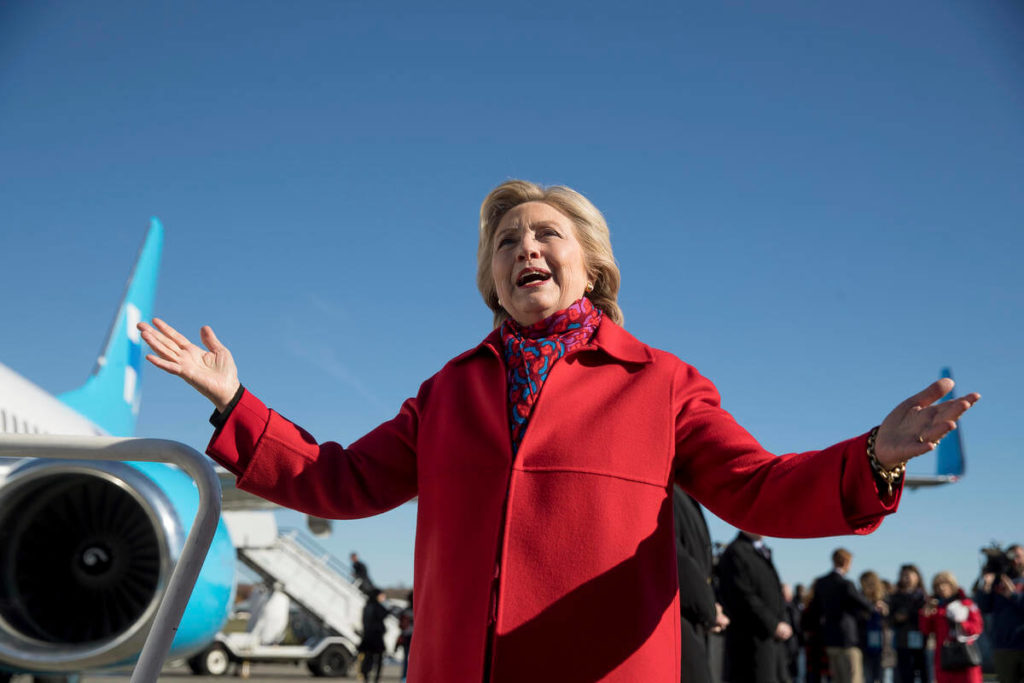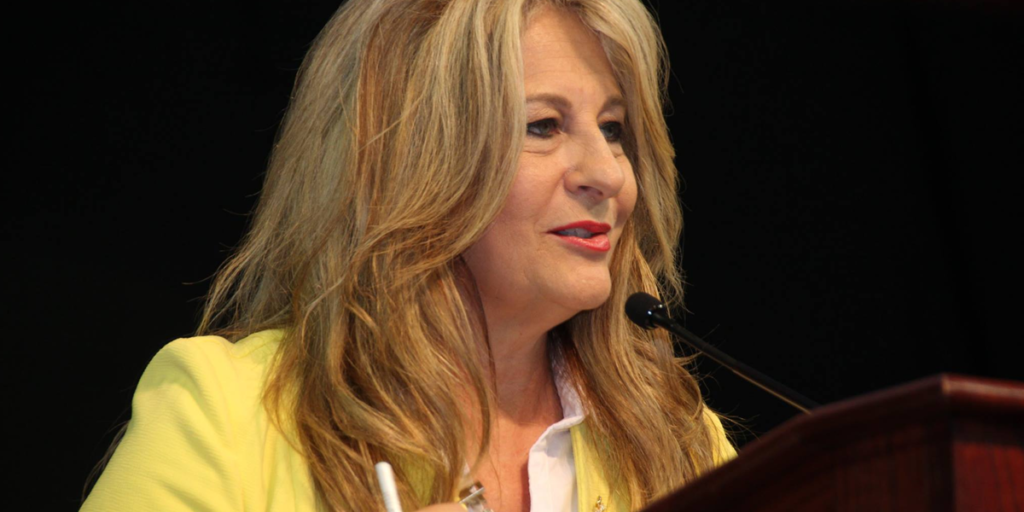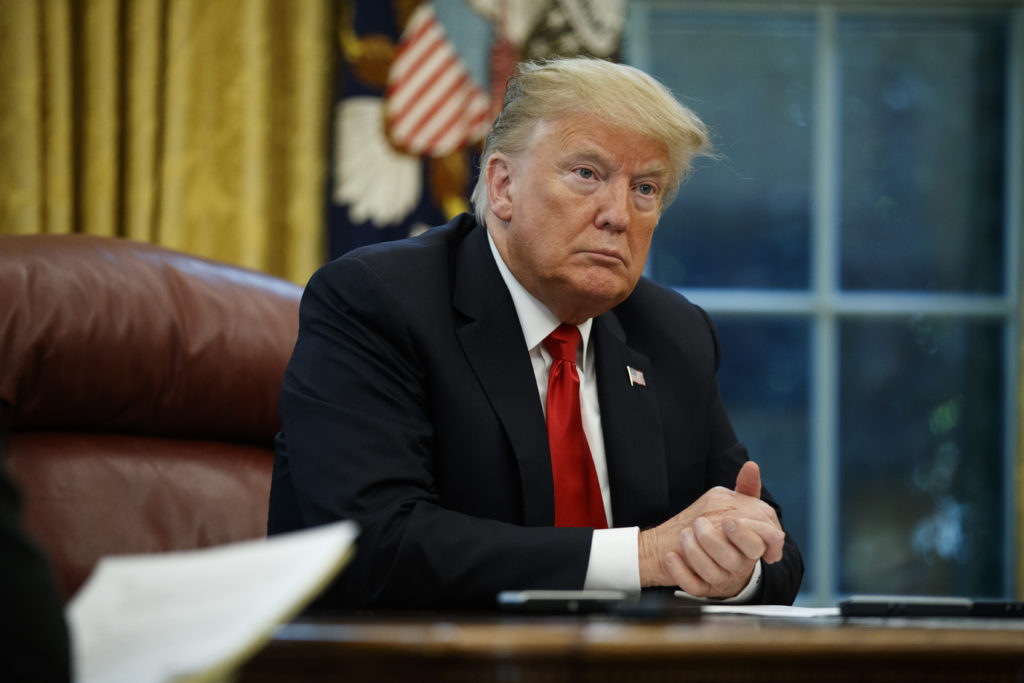Senate rejects rival Dem, GOP plans for reopening government

A splintered Senate swatted down competing Democratic and Republican plans for ending the 34-day partial government shutdown on Thursday, leaving President Donald Trump and Congress with no obvious formula for halting the longest-ever closure of federal agencies and the damage it is inflicting around the country. In an embarrassment to Trump that could weaken his position whenever negotiations get serious, the Democratic proposal got two more votes than the GOP plan. There were six Republican defectors, including freshman Sen. Mitt Romney, R-Utah, who’s clashed periodically with the president. There were signs lawmakers on both sides were seeking ways to resolve their vitriolic stalemate, if only temporarily. Moments after the votes, Senate Minority Leader Chuck Schumer, D-N.Y., spent a half-hour in the office of Senate Majority Leader Mitch McConnell, R-Ky., and a parade of senators from both parties took to the Senate floor to advocate reopening agencies for three weeks while bargainers seek a solution. “We’re talking,” Schumer told reporters, one of the most encouraging statements either side has made since the shutdown began Dec. 22. At the White House, spokeswoman Sarah Huckabee Sanders said Trump would consider signing a short-term bill “only if it includes a down payment on the wall.” For most of Thursday, both parties in conflicting ways to showed their sympathy for unpaid federal workers while yielding no ground in their fight over Trump’s demand to build a border wall with Mexico. The Senate first rejected a Republican plan reopening government through September and giving Trump the $5.7 billion he’s demanded for building segments of that wall, a project that he’d long promised Mexico would finance. The 50-47 vote for the measure fell 10 shy of the 60 votes needed to succeed. Minutes later, senators voted 52-44 for a Democratic alternative that sought to open padlocked agencies through Feb. 8 with no wall money. That was eight votes short. It was aimed at giving bargainers time to seek an accord while getting paychecks to 800,000 beleaguered government workers who are a day from going unpaid for a second consecutive pay period. Flustered lawmakers said the results could be a reality check that would prod the start of talks. Throughout, the two sides have issued mutually exclusive demands that have blocked negotiations from even starting: Trump has refused to reopen government until Congress gives him the wall money, and congressional Democrats have rejected bargaining until he reopens government. Thursday’s votes could “teach us that the leaders are going to have to get together and figure out how to resolve this,” said Sen. John Thune of South Dakota, the No. 2 Senate GOP leader. He added, “One way or another we’ve got to get out of this. This is no win for anybody.” For now, partisan potshots flowed freely. House Speaker Nancy Pelosi, D-Calif., accused Commerce Secretary Wilbur Ross of a “let them eat cake kind of attitude” after he said on television that he didn’t understand why unpaid civil servants were resorting to homeless shelters for food. Even as Pelosi offered to meet the president “anytime,” Trump stood firm, tweeting, “Without a Wall it all doesn’t work…. We will not Cave!” and no meetings were scheduled. As the Senate debated the two dueling proposals, McConnell said the Democratic plan would let that party’s lawmakers “make political points and nothing else” because Trump wouldn’t sign it. He called Pelosi’s stance “unreasonable” and said, “Senate Democrats are not obligated to go down with her ship.” Schumer criticized the GOP plan for endorsing Trump’s proposal to keep the government closed until he got what he wants. “A vote for the president’s plan is an endorsement of government by extortion,” Schumer said. “If we let him do it today, he’ll do it tomorrow, and tomorrow, and tomorrow.′ The White House closely monitored the Senate votes and Trump spoke with lawmakers throughout the day. He was waiting to see if many Democrats crossed over to back his plan, but West Virginia Sen. Joe Manchin proved to be the only one. In one indication the lawmakers were reaching a breaking point, Vice President Mike Pence attended a pre-vote lunch with GOP senators and heard eagerness for the standoff to end, participants said. Sen. Roy Blunt, R-Mo., said their message to Pence was “Find a way forward.” In consultation with their Senate counterparts, House Democrats were preparing a new border security package they planned to roll out Friday. Despite their pledge to not negotiate until agencies reopened, their forthcoming proposal was widely seen as a counteroffer to Trump. Pelosi expressed “some optimism that things could break loose pretty soon” in a closed-door meeting with other Democrats Wednesday evening, said Rep. John Yarmuth, D-Ky. The Democratic package was expected to include $5.7 billion, the same amount Trump wants for his wall, but use it instead for fencing, technology, personnel and other measures. In a plan the rejected Senate GOP plan mirrored, Trump on Saturday proposed to reopen government if he got his wall money. He also proposed to revamp immigration laws, including new restrictions on Central American minors seeking asylum in the U.S. and temporary protections for immigrants who entered the country illegally as children. In another sign of hope, Thursday’s vote on the Democratic plan represented movement by McConnell. For weeks, he’d refused to allow a Senate vote on anything Trump wouldn’t sign and has let Trump and Democrats try reaching an accord. McConnell has a history of helping resolve past partisan standoffs, and his agreement to allow Thursday’s vote was seen by some as a sign he would become more forcefully engaged. At a panel discussion held by House Democrats on the effects of the shutdown, union leaders and former Homeland Security officials said they worried about the long-term effects. “I fear we are rolling the dice,” said Tim Manning, a former Federal Emergency Management Agency official. “We will be lucky to get everybody back on the job without a crisis to respond to.” Reprinted with permission from the Associated Press
Opportunity Zone fever, debate spread from Birmingham to the Bronx

In a former warehouse on a dimly lit street in the South Bronx, developers sipping Puerto Rican moonshine listened as a local official urged them to capture a new U.S. tax break by rebuilding the decaying neighborhood. In Alabama, a young lawyer quit his job after seeing the same tax break’s potential to help one of the nation’s poorest states. He now spends his days driving his Hyundai from town to town, slideshow at the ready, hoping to connect investors with communities. And on a conference call with potential clients, a prominent hedge fund executive pitched investments in a boutique hotel in Oakland, which he described as San Francisco’s Brooklyn. The project is eligible for the same tax break, designed to help the poor. Fervor about opportunity zones is heating up across the U.S. For a limited time, investors who develop real estate or fund businesses in these areas are able to defer capital gains on profits earned elsewhere and completely eliminate them on new investments in 8,700 low-income census tracts. The goal is to reinvigorate these areas. But the question is whether the 2017 tax law will, as U.S. Treasury Secretary Steven Mnuchin predicts, pump $100 billion into places that need it most, or if investors will play it safe by funding projects in a few zones already on the upswing. There’s no lack of optimism among officials in shrinking Rust Belt towns, wind-swept Western landscapes and hurricane-ravaged Puerto Rico, who hope to jump-start local economies. The incentives are so flexible they could be used for everything from affordable housing to solar farms. Yet on the investor side, much of the attention is fixed on how to turn a profit in already thriving areas. They include neighborhoods surrounding Manhattan, Atlantic beach towns drawing vacation-home developers, bedroom communities near Silicon Valley and anomalies like Portland, Oregon, where the entire downtown was deemed eligible for the breaks. “The phrase I keep thinking of is ‘gold rush,’” said Michael Lortz, an accountant who works with developers in Portland. “There’s a lot of money from out of town that’s coming here.” Already, a policy debate is raging. Backers are urging people to reserve judgment, and they say the tax breaks have galvanized cities, businesses and investors to think creatively about boosting parts of the country most in need. Critics say the incentives were poorly calibrated and may amount to a boondoggle far in excess of the official $1.6 billion projected cost. Americans may have to wait months or years to learn which side is right. That’s because the law doesn’t require investors to disclose projects, making it difficult to tell which areas are benefiting the most. But there’s plenty of evidence that a boom is brewing. Goldman Sachs Group Inc., which already had an investment team focusing on struggling communities, has disclosed about $150 million in projects in recent months. Purchases of sites inside opportunity zones spiked as the tax law took effect, outpacing growth in other areas, according to Real Capital Analytics, which tracks property sales. Altogether, investors spent 62 percent more on properties eligible for tax breaks in the 12 months through September, compared with those in the same census tracts a year earlier, its data show. Here are snapshots of what’s happening across America: Driving Alabama Alex Flachsbart, 30, has a lot of time to talk when he’s in his SUV crisscrossing Alabama. A lawyer who specialized in economic development grants and tax breaks, he quit his job last year to start Opportunity Alabama, aiming to connect capital to worthy projects. For the past several months, he’s been educating people about opportunity zones, speaking to local officials, business owners and investors. “I have done the OZ PowerPoint God knows how many times,” Flachsbart, who grew up in the Bay Area, said from behind the wheel one day in December. When he read about opportunity zones in a 2017 draft of the Tax Cuts and Jobs Act, his mind reeled. Here was an uncapped subsidy far more flexible than anything he’d used before. It could draw investment for an array of projects. He imagined funding startups in Huntsville, where NASA’s presence has lured a deep bench of talented engineers, and the renovation of an old civic complex in Mobile. Flachsbart’s nonprofit – which has board members from the state’s largest utility and its biggest bank, Regions Financial Corp. – is now in talks for 10 potential projects that need more than $100 million in equity investment, he said. None have been funded yet, but he’s certain some will be. Meanwhile, he keeps driving. Bronx boost Port Morris Distillery, which makes a high-alcohol rum called pitorro, was the perfect spot for an opportunity zone pitch. It’s on a block with a colorful mural, industrial buildings ready for loft conversions and views of the Manhattan skyline. Much of the surrounding South Bronx is now an opportunity zone. “We have always been the most ignored,” Marlene Cintron, the borough’s head of economic development, told an audience of developers and lawyers in November. “These opportunity zones are here for you to take advantage of them.” The case for the Bronx, where incomes are among the lowest in New York, is that it’s the last borough awaiting revitalization. The tax incentives are designed to unleash it. If developers can buy at current Bronx prices, before seeing a Brooklyn-like rise, the breaks would be massive. “Huge, huge upside that you’re not going to get if you build a strip mall in Topeka,” said Terri Adler, managing partner of law firm Duval & Stachenfeld LLP, who also spoke at the event. Yet the Bronx faces a formidable problem: It’s competing with other zones across the city, including waterfronts in Brooklyn and Queens with stronger momentum. The tax break Bronx officials hope will rejuvenate their borough may instead lure more money to what looks like a safer bet across the river. In November, Amazon.com Inc. selected Long Island City for its next headquarters. Portions of that Queens neighborhood, including a former plastics factory the retailer plans
Ending showdown with Nancy Pelosi, Donald Trump postpones State of Union

President Donald Trump said he is postponing his State of the Union address until the partial government shutdown ends, yielding after a weeklong showdown with House Speaker Nancy Pelosi. Following a high-stakes game of dare and double-dare, Trump conceded Wednesday night that “no venue that can compete with the history, tradition and importance of the House Chamber.” He said he was not looking for an alternate option after Pelosi served notice earlier in the day that he wouldn’t be allowed to deliver the address to a joint session of Congress next week. Pelosi had taken the step after Trump said he planned to show up in spite of Democratic objections to the speech taking place with large swaths of the government shut down. Denied that grand venue, Trump promised to come up with some sort of alternative event. The White House scrambled to find a site matching the gravitas of the traditional address from the rostrum of the House to lawmakers from both parties, Supreme Court justices, invited guests and a television audience of millions. “As the Shutdown was going on, Nancy Pelosi asked me to give the State of the Union Address. I agreed,” Trump tweeted shortly after 11 p.m. EST. “She then changed her mind because of the Shutdown, suggesting a later date. This is her prerogative – I will do the Address when the Shutdown is over.” Pelosi said Thursday that she was thankful the president recognized it was “inappropriate” to hold the State of the Union during the government shutdown, adding “thank goodness we put that matter to rest.” Fireworks over the speech shot back and forth between the Capitol and the White House as the monthlong partial government shutdown showed no signs of ending and about 800,000 federal workers faced the prospect of going without their second paycheck in a row come Friday. Pelosi told Trump the House wouldn’t approve a resolution allowing him to address Congress until the shutdown ended. Trump shot back that Pelosi was afraid of hearing the truth. “I think that’s a great blotch on the incredible country that we all love,” Trump said earlier Wednesday. “It’s a great, great horrible mark.” The drama surrounding the State of the Union address began last week when Pelosi asked Trump to make other plans but stopped short of denying him the chamber for his address. Trump called her bluff Wednesday in a letter, saying he intended to come anyway. “It would be so very sad for our Country if the State of the Union were not delivered on time, on schedule, and very importantly, on location,” he wrote. Pelosi quickly squelched the speech, writing back that the House “will not consider a concurrent resolution authorizing the President’s State of the Union address in the House Chamber until government has opened.” The president cannot speak in front of a joint session of Congress without both chambers’ explicit permission. A resolution needs to be approved by both chambers specifying the date and time for receiving an address from the president. The gamesmanship unfolded as the Senate prepared to vote this week on dueling proposals on the shutdown. A Republican one would give Trump money for the wall while one from Democrats would re-open government through Feb. 8, with no wall money, giving bargainers time to talk about it. Both proposals were likely to fail to reach the 60-vote threshold needed in the Senate, where Republicans hold a 53-47 majority. As well, House Democrats were putting forward a new proposal, aiming to lure Trump away from his demand for a border wall by offering billions of new dollars for other border security measures. The Constitution states only that the president “shall from time to time give to the Congress Information of the State of the Union,” meaning the president can speak anywhere he chooses or give his update in writing. The address has been delayed before. Ronald Reagan’s 1986 State of the Union address was postponed after the Challenger space shuttle exploded in flight on Jan. 28 of that year. But there is no precedent for a State of the Union invitation being rescinded. Presidents Harry Truman, Dwight Eisenhower and Jimmy Carter issued their final messages in print. As Eisenhower recovered from a heart attack in 1956, he prepared a seven-minute, filmed summary of the message from his retreat in Key West, Florida, that was broadcast nationwide. Richard Nixon sent a printed message in 1973; his staff said an oral message would have come too soon after his second inaugural address. White House officials had been working on a backup plan to have Trump give the speech somewhere else if Democrats blocked access to the House chamber. Nevertheless, they were rattled by Pelosi’s move Wednesday and expressed concern it would further sour shutdown negotiations. Pelosi said that when she extended her Jan. 3 invitation to Trump to deliver the State of the Union address on Jan. 29, there was no thought that the government would still be shut down. She wrote Wednesday: “I look forward to welcoming you to the House on a mutually agreeable date for this address when government has been opened.” Moments after her letter became public, Trump told reporters he wasn’t surprised by Pelosi’s action. Democrats have become “radicalized,” he claimed. He expanded on those sentiments during a subsequent event at the White House, calling the cancellation a “disgrace” and asserting that Pelosi didn’t want to hear the truth about the need for better border security. The White House and Democratic lawmakers have been accusing one another of pettiness since Pelosi raised doubts about the speech. Trump followed up by revoking her use of a military plane for a congressional delegation visit to Afghanistan. Republished with permission from the Associated Press.
Airbus defies naysayers with Alabama plant for new jet

Airbus SE has broken ground for a new factory in Mobile, Alabama, defying predictions by archrival Boeing Co. that the plant would never be built. By midyear, mechanics will begin assembling the first American-made A220, a single-aisle jetliner developed by Bombardier Inc. and taken over by Airbus last year. Delivery of the initial plane with made-in-the-USA label is slated for next year. The new factory caps a dizzying turnaround for the Canadian-designed aircraft formerly known as the C Series, which Airbus rescued in 2018 after working for years to stymie sales. Bombardier turned to the European planemaker after Boeing rejected overtures. The U.S. aerospace giant then waged a high-profile and ultimately unsuccessful campaign to slap duties on imports of the jets by Delta Air Lines Inc. “That plane with our Airbus brand, with our support, our procurement and our sales is a game-changer,” said Jeff Knittel, Airbus’s Americas chief. Boeing spat In November 2017, Boeing at the height of the trade spat argued in a letter to U.S. Commerce Secretary Wilbur Ross that Airbus and Bombardier were “extremely unlikely ever to actually establish a C Series assembly line in Alabama.” Building a new factory would “make no economic sense,” the Chicago-based company said, contending there were too few orders to support a second production facility beyond the existing one in Mirabel, Quebec. Airbus has been shoring up sales and production of the jetliner since taking control over the unprofitable C Series program on July 1. The economic case once questioned by Boeing has grown stronger after a flurry of recent deals expanded the backlog of unfilled A220 orders to 480 aircraft. The initial sales and a top-up order by Delta show that there is ample demand to support a second factory in Mobile, Knittel said. Airbus is in discussions with several U.S. customers, he said, declining to provide specifics. “The trendline is terrific,” he said. “I am not concerned about filling the backlog.” Final assembly of the A220 jets in the U.S. “is a vital selling point for most U.S.-based customers,” Airbus said. Even so, Airbus and Bombardier plan to build the first 40 A220s ordered by Delta in Mirabel. Airbus is looking to achieve a “significant double-digit’’ reduction in production costs of the A220, said Philippe Balducchi, who runs the partnership with Bombardier. “The targets we have in our plan are achievable,’’ while conceding, “they are not easy.” The desired savings likely represent about $3 million per plane, according to Benoit Poirier, an analyst at Desjardins Capital Markets. In a twist, the new Airbus factory will be modeled on the production system that Bombardier created in Mirabel rather than mimic a neighboring A320 plant in Mobile, said Florent Massou, head of the A220 program. That’s unexpected, given the mass-production techniques that Airbus and Boeing have forged as they push single-aisle jet output to record-high levels. When Boeing took control of McDonnell Douglas Corp.’s MD-95 program following the companies’ 1997 merger, for example, engineers created an elaborate cable system to move jets and copy the moving line created for the 737 program. Tripling output The jigs, tooling and robotics at Mirabel are all cutting-edge, part of a lean production system that will eventually make 10 of the aircraft a month. But the engineers’ desks scattered around the factory floor hint at the problem-solving needed to triple output by the mid-2020s. “Technically, the production processes haven’t changed,” Massou told reporters at Mirabel this week. Rather than changing out equipment, Toulouse, France-based Airbus has focused on how work is organized to make sure that unfinished tasks aren’t handed over to workers downstream, while training mechanics to be more efficient. The Alabama final assembly line will look “exactly like this,” Massou said Jan. 14, from a balcony overlooking the Mirabel factory floor, where two lines of A220s were slowly taking shape. That’s so workers at the two factories can share the tribal knowledge that comes with repeating tasks – the learnings that drive down cost and speed production times for aircraft, he said. Boeing-Embraer Including the new factory, Airbus’s total investment in Mobile will approach $1 billion, Knittel said. Bombardier has committed to providing as much as $700 million in funding to the A220 partnership through 2021, Chief Financial Officer John Di Bert said last month. The figure includes a commitment of $350 million for 2019. Airbus and its partners are investing $300 million in the Mobile facility against the uncertain economic fallout from Brexit, and the emerging competitive threat of a joint venture that will give Boeing control of rival aircraft made by Brazil’s Embraer SA. “It’s sometimes hard to predict the future, but it didn’t take a genius” to anticipate the Boeing-Embraer tie-up, Airbus Chief Executive Officer Tom Enders told reporters. “We’re helped by the fact that we have by far the best aircraft in the A220.” (Contact the reporters at jjohnsson@bloomberg.net and tomesco@bloomberg.net.) Reprinted with permission from The Alabama NewsCenter.
Personnel Note: Retired Rear Admiral Kent Davis named head of Alabama VA

On Thursday, Governor Kay Ivey announced her selection of Alabama native Rear Admiral W. Kent Davis as commissioner of the Alabama Department of Veterans Affairs. On January 4, the State Board of Veterans Affairs voted on this selection before today’s official offer. In a press release, Ivey said “After serving his country in multiple branches of the military over the course of his distinguished career, Adm. Davis has proven himself as an excellent selection to serve as the next commissioner of the Alabama Department of Veterans Affairs. I commend the hard work of the State Board of Veterans Affairs Search Committee for recommending our next VA leader. I know that Adm. Davis will take his broad spectrum of experience and apply it well to help the honorable men and women of Alabama who have so proudly served in uniform.” According to the press release, Adm. Davis served in both the U.S. Army and U.S. Navy in active duty but, in his 30 years in uniform and 11 years of active duty, has experience with all military services. Adm. Davis, it says “Adm. Davis is one of only a few people who has served both as a field grade officer in the Army and a senior officer in the Navy.” In addition, he has a Bachelor of Science in Business Administration from Louisiana State University and his law degree from Georgia State University. AL.com reports that Adm. Davis began his career as an officer aboard the U.S.S. Missouri in 1986 and retired from the Navy in October of 2016. He has also worked as city manager for Anniston, deputy superintendent of the U.S. Department of Homeland Security’s Center for Domestic Preparedness (CDP)in Anniston, director of public affairs for U.S. detention operations in Afghanistan. He is currently chief communication officer at Air University at Maxwell Air Force Base in Montgomery. In the press release, Adm. Davis was quoted as saying, “I look forward to continuing to serve my country as the commissioner of the Alabama Department of Veterans Affairs. As a veteran myself, I understand the importance of providing help to the hundreds of thousands of Alabamians who have served in uniform,” Adm. Davis said. “It is an honor to have been chosen for this new post. I appreciate the confidence in me shown by Governor Ivey and the State Board of Veterans Affairs. I will work hard each day to ensure the veterans of Alabama are treated with the utmost respect and granted the care they so greatly deserve.” Adm. Davis told the Anniston Star that he left his position at CDP in Anniston under pressure after trying to address serious problems. “I had to walk away from that,” Davis said. “I thought, do I stay and fight this out with all the risks, or do I walk away knowing that if I resign it ends everything?” In 2017, the Alabama Department of Veterans Affairs earned national recognition for a website that improves veterans’ access to VA benefits and services.
Jim Carnes: It’s time for Alabama to go big and expand Medicaid

Alabamians expect to hear a lofty, future-oriented vision from their governor every four years during the inaugural address. Gov. Kay Ivey, speaking in Alabama’s bicentennial year, rose to this historic occasion in many ways last week. But her speech omitted one huge issue that our state should address this year: Medicaid expansion. Alabama’s quadrennium – the four-year cycle for election of all executive officers and legislators – lends a rhythm to the governing process. Election years, like 2018, typically see little bold action, as lawmakers position themselves for campaign season. But “first” years, like 2019, are often a prime opportunity to go big and tackle long-term problems. Ivey took the long view in many areas, committing to strong education funding and seeking serious investment in Alabama’s infrastructure. “Improving our infrastructure is more than an investment in our roads and bridges,” Ivey said. “It’s an investment in economic development, public safety and local communities.” These investments are critically overdue, and few could argue otherwise. But a limited definition of infrastructure – roads, bridges and prisons – would fall short of the bold vision that our state needs to prosper as it enters its third century. Alabama’s health care infrastructure needs a major boost as well, and Ivey has the power to provide one. Governor, it’s time to go big. It’s time to expand Medicaid. Already, 36 states – including Arkansas, Kentucky and Louisiana – have accepted federal support to expand Medicaid coverage to people making up to 138 percent of the federal poverty level. (That’s about $17,000 a year for an individual and around $35,500 for a family of four.) But Alabama is part of the rapidly shrinking minority of states that haven’t. This inaction is causing pain and hardship across our state. An estimated 300,000 Alabamians caught in the coverage gap – who earn too much to qualify for Medicaid but too little to qualify for subsidies for Marketplace coverage – are just one medical emergency away from financial ruin. And more and more rural communities are at risk of losing local hospitals, as seven already have in this decade. Failure to expand Medicaid is holding back Alabama’s economy as well. Our state is forfeiting hundreds of millions of dollars in annual federal funding to shore up our health care system. This money would support tens of thousands of jobs and stimulate more than $1 billion a year in economic activity. Alabama is weakening its infrastructure – and its future – by leaving health care out of the equation. Ivey is right to call for infrastructure investment. But that investment should address a wide range of our state’s needs. We need roads and bridges – and public transportation – that link people to good-paying jobs in vibrant communities that offer the health care they need. We need schools equipped to prepare our children for careers in health care and other growing fields. We need a broadband network that delivers telemedicine across the Black Belt and other rural regions. We need accessible and effective substance abuse services to lighten the burden on law enforcement and corrections. We need policies to attract more medical professionals to small towns, improving quality of life and making those areas more appealing for industrial recruitment. We need health coverage to strengthen low-income families and promote a more productive workforce. Across the country, Medicaid expansion is driving transformation in all of these arenas and more. Ivey’s inaugural speech laid out a vision for a prosperous future for Alabama. There’s no better way to jumpstart our state’s third century than by expanding Medicaid. ••• Jim Carnes is policy director of Alabama Arise, a nonprofit, nonpartisan coalition of congregations, organizations and individuals promoting public policies to improve the lives of low-income Alabamians. Email: jim@alarise.org.
Frontier Airlines to begin operations from coastal Alabama

Frontier Airlines will offer direct flights from coastal Alabama to Chicago and Denver later this year. News outlets reported Frontier will offer the service from a new passenger terminal using the Downtown Mobile Airport. Service will begin May 1 with one-way fares as low as $39 for passengers heading to Chicago who reserve flights before midnight Wednesday. Mobile Mayor Sandy Stimpson says flights from the downtown airport have been a goal for years. Supporters of the idea say a study showed using the downtown airport has more advantages than using the West Mobile Regional airport. They say the downtown airport’s location will make it more competitive with airports in Pensacola, Florida, and Biloxi, Mississippi. Via Airlines is also expected to start using the Downtown Mobile Airport in late spring. Reprinted with permission from the Associated Press
Hillary Clinton to attend Selma’s annual Jubilee Bridge Crossing

On Friday, March 1 through Sunday, March 3, Selma, Ala. will host the largest voting rights commemoration event in the country — the Bridge Crossing Jubilee — remembering the 54th anniversary of the Selma to Montgomery “Bloody Sunday” march, and according to event organizers a former First Lady will be in attendance. According to the Alabama News Network, Jubilee organizers say former First Lady and U.S. Sen. Hillary Clinton will be at this year’s event. This annual event commemorates “Bloody Sunday,” when on March 7, 1965, a group of roughly 525 African American protesters planned to cross the Edmund Pettus Bridge on their civil rights march to Montgomery to demand the right to vote. At the bridge they where they were met by more than 50 state troopers and a few dozen men on horseback. When the demonstrators refused to turn back, they were brutally beaten, leaving at least 17 hospitalized, and 40 others injured. Fighting at the Edmund Pettus Bridge on Bloody Sunday, March 7, 1965. The violent attack, which was broadcast on national television, caught the attention of millions of Americans and was aptly dubbed “Bloody Sunday” and ultimately became a rallying point for civil rights leaders. “This might be the last that you can come and hear the stories of the people who made this movement possible, so we’re really excited about the Jubilee. We’re encouraging people to support it. Support it with an ad, support it by buying tickets,” Jubilee Co-coordinator Faya Rose Toure told the Alabama News Network. Those interested in the event, may purchase a ticket online.
Terry Lathan announces re-election bid for third term as ALGOP Chair

Seeking her third term in office,Alabama Republican Party Chairman Terry Lathan announced her plans to run for a third term. “It is with humility and excitement that I announce I am running for a third term as chairman of the Alabama Republican Party. It has been a true honor and privilege to serve the ALGOP as state chair. During the four years I have been chairman, we have seen historic gains electing Republicans,” said Lathan. Below are a few items Lathan is “exceptionally proud” that highlight her and her team’s accomplishments in the 2018 election cycle: Another record-breaking general election: a statewide officer sweep, additional seats in the Alabama legislature with 71 Democrat to Republican seats flipped resulting in devastating defeat of the so called ‘Blue Wave’ in Alabama Raising over $1.188 million that fully funded our campaign plan and annual Party needs Funding and executing a seamless successful 2018 general election plan Added races expanding our base plan which produced big wins Defending and growing GOP seats in 29 counties that had head-to-head races with Democrats Maintained an aggressive year-round social media footprint to push our Party content and messaging “After forty-two years as a GOP volunteer, I still stand on our Party’s platform, values and foundation of conservative beliefs. That will never change. Elected officials, opinions and situations may change, but my lifelong commitment to Republican principles will never yield,” Lathan continued. “I will continue to reject the perception that politics gives people a ‘free pass’ to lower the bar of integrity and am determined that it is raised for all who serve in the public arena. Service in the political realm should demand the highest standard of behavior and principles. Perfection is not attainable, but personal behavior choices and honorable actions are.” Lathan is a native of Mobile, Alabama where she lives with her husband, Jerry. They have two adult children. She is a former public school teacher and has been volunteering with the Republican Party for over 40 years. She has served as Chairman of the Alabama Republican Party since February 2015, making her the longest serving female ALGOP state chairman. If re-elected will be the longest serving chair since 1985.
Mo Brooks reintroduces ‘EL CHAPO’ Act to make the Mexican cartel funds pay for border wall

When it comes to ways to pay for the U.S. border wall with Mexico, Alabama’s 5th District U.S. Rep. Mo Brooks certainly has a creative idea: use funds tied to the prosecution of Mexican drug lord Joaquín “El Chapo” Guzmán. On Wednesday, Brooks reintroduced the “Ensuring Lawful Collection of Hidden Assets to Provide Order Act,” or the “EL CHAPO Act.” The EL CHAPO Act reserves approximately $14 billion in assets forfeited to the U.S. government as a result of the criminal prosecution of El Chapo, the former leader of the Sinaloa drug cartel, as well as other drug lords, for border security funding – to include construction of the U.S.- Mexico border wall. “Radical Open Borders Democrats would rather shut down the government than provide taxpayer funding for a border wall that helps prevent thousands of American deaths each year,” said Brooks. “Fortunately, there are other ways to build a border wall, enhance border security, save American lives, and end the government shutdown that is slowly but sure hurting America’s economy and American citizens.” He continued, “Congress should end the shutdown by passing the EL CHAPO Act that, over time, funds border security and a border wall by using billions of dollars in seized drug and blood money profits from drug cartels and drug lords and reapplying those drug forfeiture monies to border security and construction of a border wall. The EL CHAPO Act kills two birds with one stone. On the one hand, it shifts drug and blood money to border security and a border wall, thus helping to save the lives of thousands of Americans who die each year at the hands of illegal aliens or because of America’s porous southern border. As a bonus, the passage of the EL CHAPO Act ends the battle over the government shutdown.” Original cosponsors of the House version of the EL CHAPO Act are: Congressman Andy Biggs (AZ-05) Congressman Mike Bost (IL-12) Congressman Kevin Brady (TX-08) Congressman Bradley Byrne (AL-01) Congressman Jeff Duncan (SC-03) Congressman Matt Gaetz (FL-01) Congressman Louie Gohmert (TX-01) Congressman Paul A. Gosar, D.D.S. (AZ-04) Congressman Mark Green (TN-07) Congressman Jody B. Hice (GA-10) Congressman Walter B. Jones (NC-03) Congressman Steve King (IA-04) Congressman Mark Meadows (NC-11) Congressman Ralph Norman (SC-05) Congressman Bill Posey (FL-08) He added, “Walls have worked since the dawn of time. Ancient civilizations employed walls to keep their citizens and property safe from harm. Today, physical barriers and fencing surround America’s most secure locations— the White House, Fort Knox, the federal supermax prison in Colorado; all have high physical barriers around them. Why? Because they work. It is absurd for anyone to argue border walls are ineffective.” The United States averages 60,000 illegal border crossings per month. “The EL CHAPO Act funds a large portion of the border wall without using taxpayer dollars and provides an alternative funding mechanism for the border wall,” Brooks explained. “With the EL CHAPO Act we can end the current impasse and resulting government shutdown. Nancy Pelosi and Chuck Schumer should listen to the American people and come to the negotiating table so we can secure our border.” Brooks sponsored the EL CHAPO Act in the 115th Congress as well. His bill is the House companion legislation to Texas Sen. Ted Cruz’s Senate bill by the same name.
Poll: Shutdown drags Donald Trump approval to yearlong low

A strong majority of Americans blame President Donald Trump for the record-long government shutdown and reject his primary rationale for a border wall, according to a new poll that shows the turmoil in Washington is dragging his approval rating to its lowest level in more than a year. Overall, 34 percent of Americans approve of Trump’s job performance in a survey conducted by The Associated Press-NORC Center for Public Affairs Research. That’s down from 42 percent a month earlier and nears the lowest mark of his two-year presidency. The president’s approval among Republicans remains close to 80 percent, but his standing with independents is among its lowest points of his time in office. “Trump is responsible for this,” said poll respondent Lloyd Rabalais, a federal contractor from Slidell, Louisiana, who’s not affiliated with either political party. The 47-year-old has been furloughed for more than a month. He said he’d need to start drawing on his retirement savings next week to pay his bills if the shutdown continues. “I do support a wall, but not the way he’s handling it,” Rabalais added. “Trump guaranteed everybody that Mexico would pay for the wall. Now he’s holding American workers like me hostage.” The drop in approval comes as Trump begins the third year of his presidency under the weight of the longest government shutdown in U.S. history, an international trade war that’s straining the global economy and new revelations about his push for a real estate deal in Russia during his 2016 campaign. Compared with earlier presidents, Trump’s approval rating has been relatively stable over the course of his presidency, ranging from the mid-30s to the mid-40s. By contrast, President Barack Obama never fell below 40 percent in polling by Gallup. Still, five presidents since Gallup began measuring presidential approval have had their rating fall into the 20s at least once, including Harry S. Truman, Richard Nixon, Jimmy Carter, George H.W. Bush and George W. Bush. Trump has never fallen into that range of historic lows, but he’s also the only president never to have reached 50 percent in Gallup’s polling. The new AP-NORC poll shows most Americans see the shutdown as a major problem, and they blame Trump far more than congressional Democrats for the mess that has ensnared the lives of roughly 800,000 government workers who are going without pay. Sixty percent of Americans say Trump bears a great deal of responsibility for the shutdown. About a third place the same amount of blame on congressional Democrats (31 percent) or Republicans (36 percent). Sixty-five percent of Americans, including 86 percent of Democrats, 69 percent of independents and 33 percent of Republicans, call the shutdown a major problem. Trump may be popular overall with Republicans, but a sizable share holds him responsible for the current situation. Almost 3 in 10 Republicans think Trump bears a great deal of responsibility, while 73 percent of his party says he’s at least partly responsible. “The large part of the responsibility belongs to the president because he made the decision,” said poll respondent Sandra Olson, of Northwood, Iowa. The 76-year-old registered Republican said she voted for Trump once and likely will again. “We have never in my lifetime seen a president who has been so maligned and attacked and vilified,” Olson said. Trump’s demand for a $5.7 billion border wall is also unpopular. Overall, 49 percent of Americans oppose the plan to build a massive wall along the Mexican border; 36 percent of the nation is in favor. Opinions fall largely along ideological lines, with 8 in 10 Democrats opposing the wall and nearly 8 in 10 Republicans supporting it. About 7 in 10 supporters of the wall prefer to extend the shutdown than to reach a deal without funding it, while a nearly identical number on the other side would rather the shutdown continue than provide that funding. The poll shows significant skepticism of the president’s argument that a wall would significantly reduce crime, stem the flow of illegal drugs or help the U.S. economy. The poll was conducted the week after Trump used such factors to justify his demand for the wall during a primetime address from the Oval Office. In the nationally televised speech, he highlighted the case of one immigrant in the country illegally accused of beheading and dismembering an American citizen. About 6 in 10 Americans do say the wall would at least slightly decrease the number of people entering the U.S. illegally, though only 3 in 10 think the number would significantly decrease. Yet just 35 percent of Americans believe the wall would make the country safer, while a majority of Americans — 57 percent— believe it would make no difference to safety in the U.S. Only 21 percent believe the wall would significantly reduce the availability of illegal drugs in the nation, though 28 percent say access to illegal drugs would be slightly reduced; 49 percent say the wall would have no effect. On the economy, about as many Americans say the border wall would do more to help — almost 3 in 10 — as say it would do more to hurt; 43 percent say the wall would not make much difference to the U.S. economy. Poll respondent Kelley Thorson, of St. Robert, Missouri, who backed Trump in the 2016 election, says she supports the wall but largely disagrees with the president’s rationale. “I can’t say it would make us safer,” the 57-year-old said. “Criminals are going to get here no matter what.” While partisan opinions of Trump have remained relatively constant throughout his presidency, the poll shows that disapproval has grown particularly among independents who do not lean toward either party. Just 28 percent of independents say they approve, compared with 71 percent who disapprove. In December, 37 percent of independents approved of Trump’s job performance, while 58 percent disapproved. Women also are more likely to disapprove today compared with a month ago — 71 percent to 58 percent. And 76 percent of college graduates disapprove
2020 Democratic primary field puts diversity in spotlight

The early days of the Democratic primary campaign are highlighting the party’s diversity as it seeks a nominee who can build a coalition to take on President Donald Trump. Of the more than half dozen Democrats who have either moved toward a campaign or declared their candidacy, four are women: Sens. Kirsten Gillibrand of New York, Kamala Harris of California and Elizabeth Warren of Massachusetts and Rep. Tulsi Gabbard of Hawaii. Harris is also African-American. Former Obama Cabinet member Julian Castro, who is Latino, has also joined the race. And on Wednesday, Democrat Pete Buttigieg, the 37-year-old mayor of South Bend, Indiana, jumped into the campaign. If he wins the Democratic nomination, he would be the first openly gay presidential nominee from a major political party. He would also be the youngest person ever to become president if he wins the general election. The diversity is likely to expand in the coming weeks as other Democrats enter the race. The field that’s taking shape follows a successful midterm election in which Democrats elected a historically diverse class of politicians to Congress, a pattern they’d like to repeat on the presidential scale. Neera Tanden, president of the liberal Center for American Progress Action Fund, hailed the Democrats’ multiple trailblazing candidates for reflecting that “the central opposition to Trump is around a vision of the country that’s inclusive of all Americans.” “A lot of different people are going to see that they can be part of the Democratic Party” thanks to a field that showcases women, candidates of color, and the first potential LGBT nominee, Tanden said. The primary “hopefully will bring a lot of people into the process,” she added, recalling the high number of voters who engaged in a 2008 Democratic primary that featured a possible female nominee, Hillary Clinton, and the man who would become the first black president, Barack Obama. The array of backgrounds was on display Wednesday when Buttigieg spoke in personal terms about his marriage. “The most important thing in my life — my marriage to Chasten — is something that exists by the grace of a single vote on the U.S. Supreme Court,” Buttigieg told reporters. “So I’m somebody who understands — whether it’s through that or whether it’s through the fact that I was sent to war on the orders of the president — I understand politics not in terms of who’s up and who’s down or some of the other things that command the most attention on the news but in terms of everyday impacts on our lives.” Gillibrand has put her identity as a mother at the core of her campaign, and Harris launched her campaign on this week’s Martin Luther King holiday, a nod to her historic bid to become the first black woman elected president. A number of high-profile candidates remain on the sidelines, including two who would further bolster the diversity of the 2020 field: Sens. Cory Booker of New Jersey, who is black, and Amy Klobuchar of Minnesota. Booker, who’s widely expected to join the presidential fray in the coming days, visited the pivotal early-voting state of South Carolina this week for public events honoring King and private meetings with local activists. Klobuchar is set to speak at the University of Pennsylvania on Thursday about her work on the Senate Judiciary Committee, where Booker and Harris also are members. The affable Midwesterner recently told MSNBC that her family “is on board” if she opts to run in 2020, though she’s offered little clarity about her timetable to announce a decision. Though Klobuchar would be the fifth major female candidate in the Democratic primary, female candidates shouldn’t be shoehorned into a “narrative” dominated by their identity that excludes the policies they’re championing, said Virginia Kase, CEO of the League of Women Voters. Kase pushed back at one popular 2018 narrative in a recent interview, noting that that “every year is the year of the woman — the reality is that we’ve always been major contributors” in the electoral process. Rashad Robinson, executive director of the civil rights-focused nonprofit Color of Change, said in an interview that the diversity of the Democratic field is “a great thing and we should celebrate it,” adding that, “Our work is always about changing the rules — changing the rules of who can run and who can rule and who can lead is incredibly important.” But in addition to those “unwritten rules,” Robinson pointed to the urgency of changing the “written rules” of American life, adding that “diversity alone does not mean structures and policies and practices that have held so many back will change” overnight. Meanwhile, three white male candidates who could scramble the race — former Vice President Joe Biden, Sen. Bernie Sanders of Vermont, and former Texas Rep. Beto O’Rourke — are still weighing their own presidential plans. Biden addressed a key vulnerability in his potential candidacy this week by publicly airing regret about his support for a 1994 crime bill that’s had particularly negative effects on African-American communities, while Sanders built his own new connections to black voters during a trip to South Carolina. As Biden mulls a run for president, his allies have been sending supporters a memo that could serve as a rationale for a campaign. The memo hails Biden’s long track record in politics and argues that at a time of “unprecedented political chaos” during Trump’s administration, Biden would offer “trustworthy, compassionate leadership.” O’Rourke, for his part, continues to gauge his own future amid pundits’ criticism about blog posts he published during a recent road trip through multiple states. The 46-year-old Texan acknowledged that he’s been “in and out of a funk” following his departure from Congress after losing a high-profile Senate race in November, sparking questions about the luxury of his indecision given the family wealth and network of passionate backers he can lean on. As the Democratic field is poised to become more diverse, Republicans say Trump will run for re-election based on his


